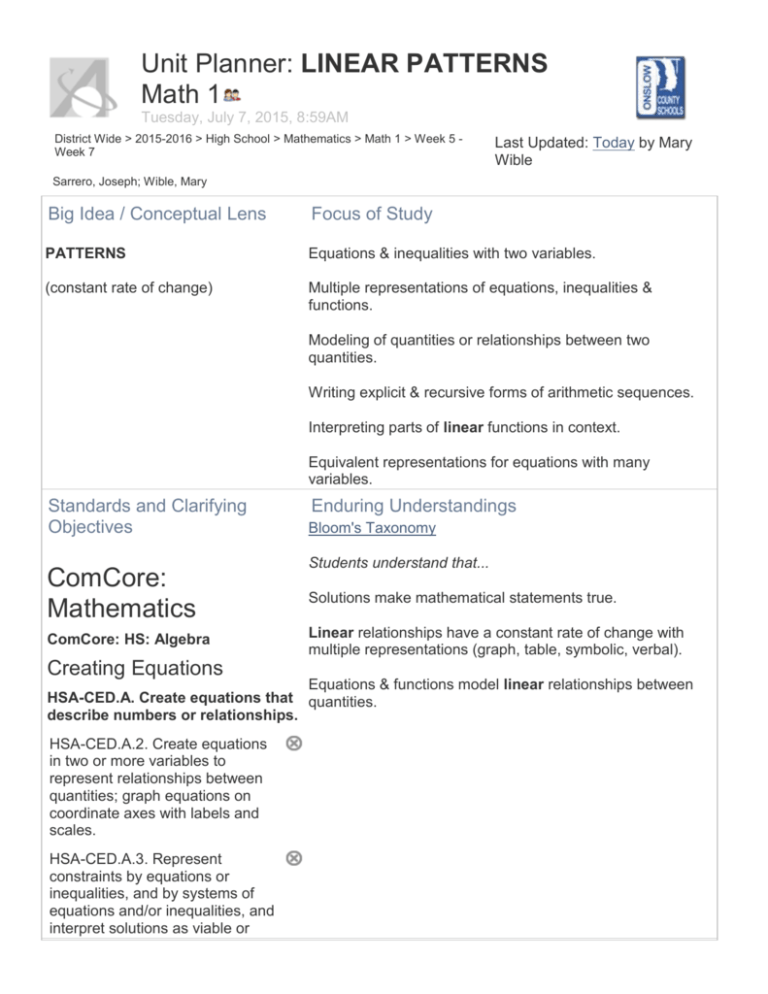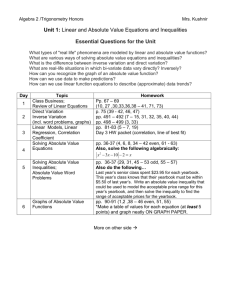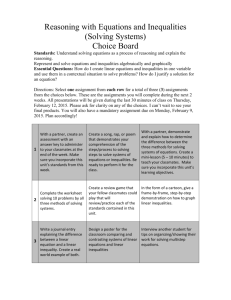
Unit Planner: LINEAR PATTERNS
Math 1
Tuesday, July 7, 2015, 8:59AM
District Wide > 2015-2016 > High School > Mathematics > Math 1 > Week 5 Week 7
Last Updated: Today by Mary
Wible
Sarrero, Joseph; Wible, Mary
Big Idea / Conceptual Lens
Focus of Study
PATTERNS
Equations & inequalities with two variables.
(constant rate of change)
Multiple representations of equations, inequalities &
functions.
Modeling of quantities or relationships between two
quantities.
Writing explicit & recursive forms of arithmetic sequences.
Interpreting parts of linear functions in context.
Equivalent representations for equations with many
variables.
Standards and Clarifying
Objectives
ComCore:
Mathematics
ComCore: HS: Algebra
Creating Equations
Enduring Understandings
Bloom's Taxonomy
Students understand that...
Solutions make mathematical statements true.
Linear relationships have a constant rate of change with
multiple representations (graph, table, symbolic, verbal).
Equations & functions model linear relationships between
HSA-CED.A. Create equations that quantities.
describe numbers or relationships.
HSA-CED.A.2. Create equations
in two or more variables to
represent relationships between
quantities; graph equations on
coordinate axes with labels and
scales.
HSA-CED.A.3. Represent
constraints by equations or
inequalities, and by systems of
equations and/or inequalities, and
interpret solutions as viable or
nonviable options in a modeling
context.
Show details
HSA-CED.A.3. Represent
constraints by equations or
inequalities, and by systems of
equations and/or inequalities, and
interpret solutions as viable or
nonviable options in a modeling
context.
Reasoning with Equations
& Inequalities
HSA-REI.D. Represent and solve
equations and inequalities
graphically.
HSA-REI.D.10. Understand that
the graph of an equation in two
variables is the set of all its
solutions plotted in the coordinate
plane, often forming a curve
(which could be a line).
HSA-REI.D.12. Graph the
solutions to a linear inequality in
two variables as a half-plane
(excluding the boundary in the
case of a strict inequality), and
graph the solution set to a system
of linear inequalities in two
variables as the intersection of the
corresponding half-planes.
ComCore: HS: Functions
Interpreting Functions
HSF-IF.A. Understand the concept
of a function and use function
notation.
HSF-IF.A.1. Understand that a
function from one set (called the
domain) to another set (called the
range) assigns to each element of
the domain exactly one element of
the range. If f is a function and x is
an element of its domain, then f(x)
denotes the output of f
corresponding to the input x. The
graph of f is the graph of the
equation y = f(x).
HSF-IF.A.2. Use function notation,
evaluate functions for inputs in
their domains, and interpret
statements that use function
notation in terms of a context.
HSF-IF.B. Interpret functions that
arise in applications in terms of the
context.
HSF-IF.B.4. For a function that
models a relationship between two
quantities, interpret key features of
graphs and tables in terms of the
quantities, and sketch graphs
showing key features given a
verbal description of the
relationship.
Show details
HSF-IF.B.4. For a function that
models a relationship between two
quantities, interpret key features of
graphs and tables in terms of the
quantities, and sketch graphs
showing key features given a
verbal description of the
relationship.
HSF-IF.B.5. Relate the domain of
a function to its graph and, where
applicable, to the quantitative
relationship it describes.
Show details
HSF-IF.B.5. Relate the domain of
a function to its graph and, where
applicable, to the quantitative
relationship it describes.
HSF-IF.B.6. Calculate and
interpret the average rate of
change of a function (presented
symbolically or as a table) over a
specified interval. Estimate the
rate of change from a graph.
HSF-IF.C. Analyze functions using
different representations.
HSF-IF.C.7. Graph functions
expressed symbolically and show
key features of the graph, by hand
in simple cases and using
technology for more complicated
cases.
HSF-IF.C.7a. Graph linear and
quadratic functions and show
intercepts, maxima, and minima.
HSF-IF.C.9. Compare properties
of two functions each represented
in a different way (algebraically,
graphically, numerically in tables,
or by verbal descriptions).
Show details
HSF-IF.C.9. Compare properties
of two functions each represented
in a different way (algebraically,
graphically, numerically in tables,
or by verbal descriptions).
Building Functions
HSF-BF.A. Build a function that
models a relationship between two
quantities.
HSF-BF.A.1. Write a function that
describes a relationship between
two quantities.
HSF-BF.A.1a. Determine an
explicit expression, a recursive
process, or steps for calculation
from a context.
HSF-BF.A.2. Write arithmetic and
geometric sequences both
recursively and with an explicit
formula, use them to model
situations, and translate between
the two forms.
HSF-BF.B. Build new functions
from existing functions.
HSF-BF.B.3. Identify the effect on
the graph of replacing f(x) by f(x) +
k, k f(x), f(kx), and f(x + k) for
specific values of k (both positive
and negative); find the value of k
given the graphs. Experiment with
cases and illustrate an explanation
of the effects on the graph using
technology. Include recognizing
even and odd functions from their
graphs and algebraic expressions
for them.
Linear, Quadratic, and
Exponential Models
HSF-LE.A. Construct and compare
linear and exponential models and
solve problems.
HSF-LE.A.1. Distinguish between
situations that can be modeled
with linear functions and with
exponential functions.
HSF-LE.A.1a. Prove that linear
functions grow by equal
differences over equal intervals,
and that exponential functions
grow by equal factors over equal
intervals.
HSF-LE.A.1b. Recognize
situations in which one quantity
changes at a constant rate per unit
interval relative to another.
HSF-LE.A.2. Construct linear and
exponential functions, including
arithmetic and geometric
sequences, given a graph, a
description of a relationship, or two
input-output pairs (include reading
these from a table).
HSF-LE.B. Interpret expressions for
functions in terms of the situation
they model.
HSF-LE.B.5. Interpret the
parameters in a linear or
exponential function in terms of a
context.
Essential Concepts and Critical Processes, Strategies, and Skills
Content
8 Mathematical Practices:
Key Words:
equation, inequality, solution,
MP 1 Make sense of problems, & persevere.
unknown, function, linear, constraint,
viable, arithmetic, sequence, rate of
change, explicit, recursive
MP 2 Reasoning abstractly & quantitatively.
MP 3 Critiquing reasoning of others & justifying own
work.
(Review: slope, intercept, maximum,
minimum)
MP 4 Model with mathematics.
Concepts:
MP 5 Use tools of appropriately.
solution, model, function, constraint,
equality, rate of change
MP 6 Attend to precision.
MP 7 Seeing Structure.
Critical Content:
Steps to rewrite linear equations &
inequalities.
MP 8 Seeing regularity in repeated reasoning &
patterns.
Process#1: (connects to MP 1,2,4,6,7,8)
Evaluation of viability of solutions &
constraints.
Interpretations of word problems,
tables, graphs, & equations.
Analyzing a prompt.
Strategies:
Identifying key words in context.
Creation of various representations to include graphs, tables, explicit &
Recognizing format of information.
recursive equations, word problems &
functions.
Creating a visual representation if none is given.
*Weekly Learning Targets for Unit
attached below.
Learning Targets for Linear
Unit.docx
Skills:
Identify intercepts, rate of change from tables, graphs,
equations and word problems.
Create tables, graphs, and equations from word problems.
Interpret tables, graphs, and equations.
Process #2: (connects to MP 1,2,3,6,7)
Explain reasoning and justify mathematical choices.
Strategies:
Identify what information is required.
Create a plan to present information verbally or visually in a
logical fashion.
Skills:
Use content specific vocabulary.
Use transitional phrases.
Show work to reflect the use of mathematical properties &
structure.
Compare result to constraints & conditions of problem.
Process #3: (connects to MP4,5,8)
Create & move between representations.
Strategies:
Identifying key features & key terms.
Create frayer model or similar graphic organizer to show
different representations of same features.
Skills:
Read table to find pattern of rate of change & intercepts.
Read graphs to find rates of change & intercepts.
Interpret coefficients & constants of equations in context of
word problem.
Essential Questions
Resources/Materials
Factual
Resources listed below:
1. How do I represent the solutions of #1 Identifying & interpreting Rate of Change from Growth
bivariate linear equations &
Charts. Includes opportunity to incorporate reading
inequalities?
information in text & from chart.
1 What are the similarities &
differences between bivariate linear
equations & linear inequalities?
2 How can I model a linear
relationship?
#2 Interpreting functions in multiple formats from
context. Speeding Ticket Lesson Set leads students
through applications of linear relationships between
speeding fines & speeds.
#3 Finding & interpreting intercepts in context Balloon
fundraiser. Heavily scaffolded lesson to find & interpret x
2 How are the key features of various and y-intercepts in context, from equation & graph.
linear models identified & interpreted?
#4 Graphing inequalities MATHSHELL lesson. Includes
pre-assmt, activity, & post assmt suggestions as well as
3 How do I create bivariate linear
suggestions for guiding questions. Students graph several
equations & inequalities to model
inequalities on one grid to find "hidden" point. Could also be
situations?
3 How do I write bivariate linear
inequalities to model maximizing &
minimizing situations?
3 What is a constraint?
Conceptual
1 What is a solution?
1 How many solutions could there be
for a linear relationship?
used with systems of inequalities.
#5 Building & comparing functions Digital Downloads.
Investigation which challenges students to create, interpret
& compare tables, graphs, and functions from context.
#6 & 7 Conceptualizing & Representing linear
relationships Reginas Logos Attachment #6- Students
must match table, graph, diagram, and recursive formula &
then generate explicit formula. Can be done as small group
task. Attachment #7 is a one page worksheet that presents
the same diagrams but requires students to create other
representations.
1 When is a solution viable in context?
1 Why are variables sometimes used
to represent coefficients?
2 What are the similarities &
differences between equations and
functions?
#8 Vertical Translations Worksheet Problems requiring
students to identify "k" from transformations.
#9 Vertical & Horizontal Translations Investigation Students
create tables & graphs from equations written in function
notation f(x); g(x)= f(x) + k, and h(x) = f(x + k)
#10 Very good website for common core aligned lessons.
Take caution to cross-check with NC Math 1 standards!
2 How are tables, graphs, and other
representations of linear functions and These materials are for NY Algebra 1 standards & therefore
arithmetic sequences related to each require some modification or thoughtful selection.
other?
*Also see the foldables at the bottom of the page under
3 What makes a piece of information Differentiation and Linear Functions Menu task under
Assessment.
in a situation "unknown"?
3 What is the importance of
constraints in a linear relationship?
3 How does changing one condition in
a relationship impact the linear
models?
Provocative
1 What conditions impact the type and
number of possible solutions?
1 Why are some solutions
mathematically correct yet not feasible
in context?
2 Is there more than one way to write
a linear model for a situation?
2 When is one representation of a
linear model more appropriate than
GrowthRate-AS-HeightAgeChart.pdf
Speeding Ticket Investigation Packet update.pdf
Finding & inter Intercepts of a Graph Activity.pdf
defining_regions_using_inequalities_MATHSHELL.pdf
digital downloads.docx
Regina's Logos Update.docx
Reginas_Logo.pdf
Linear Transformations EOC Practice.docx
InvestigTransf of linear.docx
https://www.engageny.org/resource/high-school-algebra-i
another?
3 Are there other patterns for data (in
addition to linear)?
3 Does every relationship have a
pattern?
3 How does the ability to predictions
from data impact real world decisions?
Formative, Interim, and Summative Assessments
Everything You Wanted to Know About...
Pre Assessment: Other: Teacher/Student Interaction
Students are presented with the graph of a line and are given 3 minutes to brainstorm
information about the line from that graph.
Can be followed with brief class discussion.
everything you want to know.docx
2 Standards Assessed
QUICK WRITE - solutions
Formative: Written: Quick Write
Students read a graph & defend a claim related to the solutions of the line shown.
QUICK WRITE solutions.docx
1 Standard Assessed
Linear Functions Menu Assmt
Formative: Performance: Skill Demonstration
Menu Task allows students to choose from a "menu" of functions to construct & model.
LINEAR FUNCTIONS MENU ASSESSMENT.docx
3 Standards Assessed
Toothpick Triangles PaperSlides
Summative: Performance: Authentic Task
Students view brief Dan Meyer's video on toothpick triangle patterns & must create multiple
representations for the patterns the see.
Students present their work digitally using PaperSlides video. Option to extend to peer review &
assessment using QR codes or other digital tool.
Toothpick Triangles - Perf Assmt.docx
5 Standards Assessed
UNIT TEST - Part A
Summative: Test: Post Test
20 Questions multiple choice & free response aligned to standards for the first part of instruction
in the 3 week unit.
Math 1 UNIT TEST part A.docx
14 Standards Assessed
UNIT TEST - Part B
Summative: Test: Post Test
20 Questions multiple choice, free response & one written prompt aligned to standards for the
last part of the linear unit.
Math 1 UNIT TEST part B.docx
8 Standards Assessed
Integration Opportunities
(Optional)
Additional Integration Opportunities (Optional)
READING:
P21: 21st Century
Student Outcomes
P21: K-12
Students will use critical reading strategies listed in
processes when analyzing prompts such as Digital
Downloads, and Growth Rate as well as test prompts.
WRITING:
will use mathematically precise vocab to create
Learning & Innovation Skills Students
written arguments and explanations in tasks such as Quick
Critical Thinking and Problem
Solving Reason Effectively
Show details
Use various types of reasoning
(inductive, deductive, etc.) as
appropriate to the situation
Make Judgements and Decisions
Show details
Synthesize and make connections
between information and
arguments
Collaborate with Others
Show details
Assume shared responsibility for
collaborative work, and value the
individual contributions made by
each team member
Life & Career Skills
Be Flexible
Show details
Deal positively with praise,
setbacks and criticism
Work Independently
Show details
Monitor, define, prioritize and
complete tasks without direct
oversight
Be Self-directed Learners
Show details
Reflect critically on past
experiences in order to inform
future progress
Write.
SPEAKING & LISTENING:
Students will critique reasoning of others & share their own
reasoning using mathematically precise vocabulary,
appropriate expressions of
agreement/disagreement.(Everything You Want to Know &
Toothpick Triangles)
TECHNOLOGY:
Students will use digital tools to create work product for the
Toothpick assessment & viewing videos.
Social and Cross-Cultural Skills
Interact Effectively with Others
Show details
Know when it is appropriate to
listen and when to speak
Character Qualities (Optional)
Self-discipline
Responsibility
Integrity
Cooperation
Continue to
model &
develop
these
character
traits
throughout
the first
grading
period. It is
particularly
important to
model,
remind,
reinforce
expected
behavior for
investigations
&
performance
tasks.
Differentiation/Intervention Focus Areas (Optional
Visual aids support students who need more structure &
also appeal to students with visual learning preferences.
The Foldables consolidate information about the different
forms of linear equations. This is a review of information
from 8th grade math that many students need to revisit.
The UNIT Graphic Organizer helps make the connections
between concepts & topics clear to the students.
*Also refer to the Linear Functions Menu Task for a
Differentiated Assessment.
FOLDABLE - Different Forms of Linear Functions.pptx
FOLDABLE - eq of lines.docx
GRAPHIC_ORGANIZER_LINEAR_FUNCTIONS_UNIT.docx
Atlas Version 8.1.1
© Rubicon International 2015. All rights reserved









